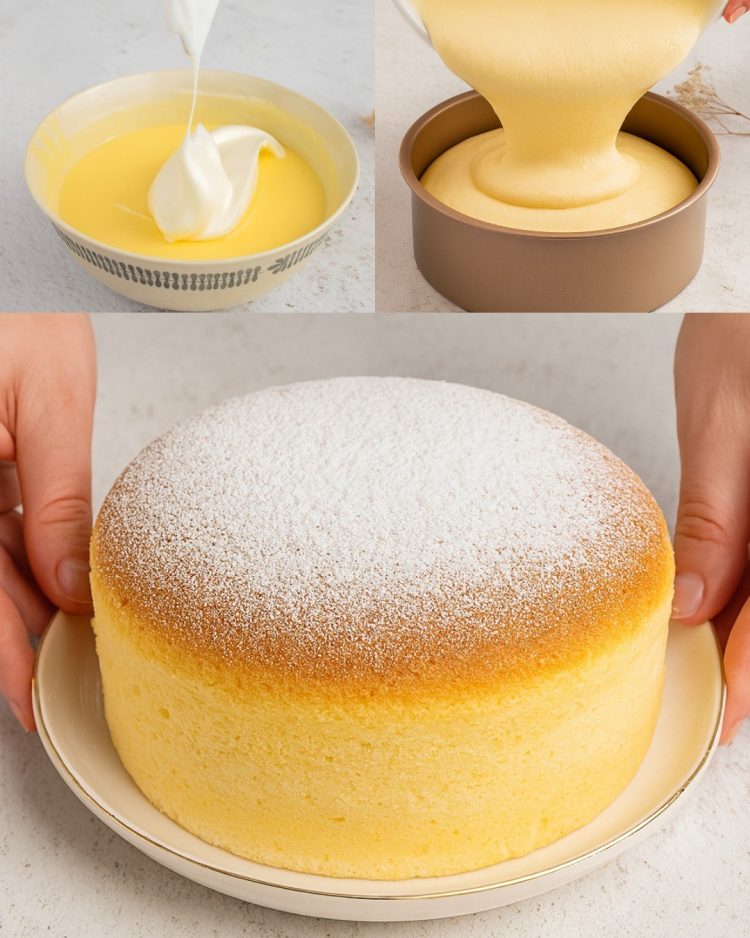Japanese Souffle Cheesecake is a delicious dessert, with a frothy texture and neutral flavor. Unlike the classic American cheesecake, it is soft as a cloud, thanks also to the steaming: it is also called “cotton cake” because it resembles a cotton ball.
To prepare it, we mixed together cream cheese and butter, melting them in a bain-marie, before adding the milk, flour, egg yolks and egg whites whipped with lemon juice and sugar. The mixture will be poured into the mold and cooked in a bain-marie in the oven for about 50 minutes at 320°F (160°C). Once ready, enjoy it for breakfast, as a snack, accompanied by a cup of milk or tea or serve it as a delicious dessert at the end of a meal. You can sprinkle it with icing sugar, if you prefer.
What is Japanese Cheesecake?
Japanese cheesecake, also known as cotton cheesecake or soufflé cheesecake, originated in Japan during the 1960s, inspired by the lighter, fluffier style of Western cheesecakes. Created by Japanese pastry chefs who blended techniques from French soufflés and traditional American cheesecakes, it uses whipped egg whites to achieve its signature airy texture. Its unique combination of lightness and richness quickly made it a favorite in Japan.
The cake’s popularity spread internationally in the late 20th century, driven by the global fascination with Japanese desserts and viral food trends. In the West, its mesmerizing jiggle and delicate flavor captivated social media and food enthusiasts, earning it a place in bakeries and kitchens worldwide. Today, Japanese cheesecake is celebrated for its melt-in-your-mouth texture and simple yet elegant appeal.
Pro Tips for The Best Japanese Cheesecake
Ensure cream cheese, eggs, and butter are at room temperature for a smoother batter.
Beat the egg whites until they form stiff peaks, but avoid over-whipping, as this can make the cake dense.
Line the cake mold with parchment paper to prevent sticking and ensure easy removal.
The hot water bath keeps the oven humid, ensuring a moist and even bake without cracks.
Bake at the specified low temperature (160°C/320°F) to prevent the cake from rising too quickly or cracking.
Allow the cheesecake to cool slowly in the oven with the door slightly ajar to avoid sudden temperature changes that cause deflation.
The cake should be slightly wobbly in the center when done. Overbaking can dry it out.
Japanese Cheesecake Vs. American Cheesecake
Japanese cheesecake is different compared to American-style cheesecakes in several key ways. It’s much lighter and airier compared to dense, creamy American cheesecakes. This is because egg whites are added to the batter, which makes Japanese cheesecakes much lighter. They’re also not as sweet as traditional American cheesecakes, and don’t have crusts.
Is It Difficult to Make Japanese Cheesecake?
Japanese cheesecake can be tricky due to its delicate texture and precise techniques, like whipping egg whites to stiff peaks and folding them gently into the batter. Maintaining the right oven temperature and using a water bath are also crucial. However, with attention to detail and practice, it’s manageable even for home bakers!
Why Is My Japanese Cheesecake so Tough and Not Fluffy?
A Japanese cheesecake might turn out tough instead of fluffy if the egg whites were over-whipped or under-whipped, making it hard to fold properly. Overmixing the batter can deflate the air, while baking at too high a temperature or skipping the water bath can result in a dense texture.
Help! My Cheesecake Deflated!
The cheesecake might have deflated due to sudden temperature changes after baking. Removing it from the oven too quickly or not letting it cool gradually can cause it to collapse. Over-whipping the egg whites or underbaking the cake can also lead to deflation.
How Do You Eat Japanese Cheesecake?
Japanese cheesecake can be enjoyed warm for a soft, soufflé-like texture or chilled for a firmer, creamy consistency. It’s often served plain, dusted with powdered sugar, or accompanied by fresh fruits, whipped cream, or a light drizzle of honey or sauce.
What Does Japanese Cheesecake Taste Like?
Japanese cheesecake tastes light, fluffy, and slightly tangy from the cream cheese, with a hint of sweetness. It’s less rich than traditional cheesecakes, combining the airy texture of a soufflé with the creaminess of cheesecake, making it delicate and refreshing.
How Do I Avoid a Crack on Top of My Cheesecake?
To avoid cracks on your Japanese cheesecake, bake it in a water bath to maintain even moisture and temperature. Use low heat, avoid overmixing the batter, and cool the cake gradually in the oven with the door slightly ajar to prevent sudden temperature changes.
see continuation on next page
